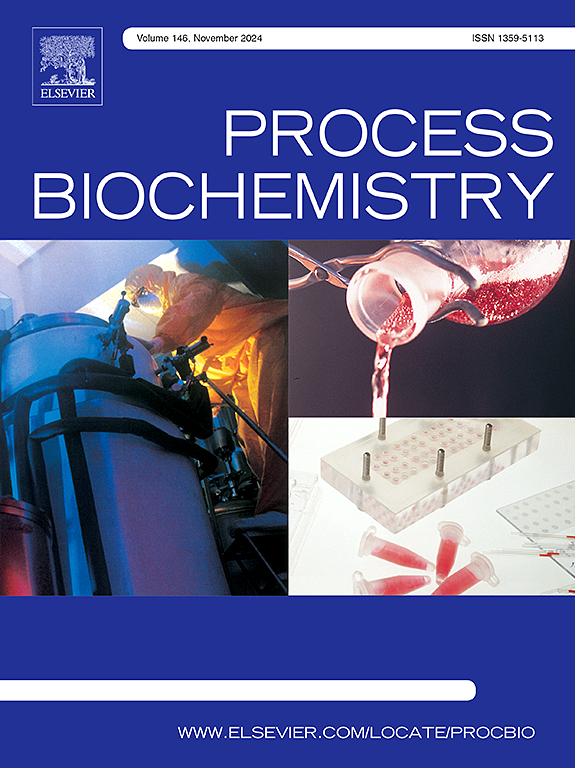Development of a versatile and high-loading capacity yeast surface assembly system via SpyC/SpyT conjugation
IF 3.7
3区 生物学
Q2 BIOCHEMISTRY & MOLECULAR BIOLOGY
引用次数: 0
Abstract
The yeast surface display (YSD) system for enzyme immobilization has a wide range of applications and is of great value in various studies. However, despite the many advantages of the YSD system, the amount of proteins it can display is limited, which restricts its potential applications. To enhance the applicability of the YSD system, we introduced a highly efficient and stable conjugation tool (SpyCatcher-SpyTag (SpyC-SpyT)) into the YSD system and developed a Saccharomyces cerevisiae surface assembly (SSA) system with high loading capacity. The SpyC-SpyT can spontaneously form molecular isopeptide bonds, and the target proteins can be assembled in the SSA system within 5 min. By increasing the copy of SpyC and integrating the expression fragment into the rDNA region, we successfully screened a genetically stable and high-copy strain that could assemble ∼7.8 × 106 SpyT-eGFP molecular count/cell. The organophosphate hydrolase immobilized by the SSA system not only has the similar enzyme activity as the free enzyme, but also has improved thermal stability and enhanced tolerance to acidic and alkaline environments. Further, we found that the immobilized enzyme still retained 77.7 % of its enzyme activity after 6 cycles. In conclusion, we successfully constructed a novel, efficient and stable SSA system for the development of the YSD system.
利用SpyC/SpyT偶联技术开发一种多功能高负荷酵母表面组装系统
酵母表面显示(YSD)系统具有广泛的应用前景和广泛的研究价值。然而,尽管YSD系统有许多优点,但它可以显示的蛋白质数量有限,这限制了它的潜在应用。为了提高YSD系统的适用性,我们在YSD系统中引入了高效稳定的偶联工具SpyCatcher-SpyTag (SpyC-SpyT),并开发了具有高负载能力的Saccharomyces cerevisiae表面组装(SSA)系统。SpyC-SpyT可以自发形成分子异肽键,目标蛋白在5 min内即可在SSA系统中组装完成。通过增加SpyT-eGFP的拷贝数并将表达片段整合到rDNA区域,我们成功筛选了一种遗传稳定的高拷贝菌株,该菌株可以组装约7.8 × 106 SpyT-eGFP分子计数/细胞。经SSA体系固定化的有机磷酸酶不仅具有与游离酶相近的酶活性,而且具有较好的热稳定性,增强了对酸性和碱性环境的耐受性。此外,我们发现固定化酶在6个循环后仍保持77.7% %的酶活性。综上所述,我们成功构建了一个新颖、高效、稳定的SSA系统,为YSD系统的开发提供了基础。
本文章由计算机程序翻译,如有差异,请以英文原文为准。
求助全文
约1分钟内获得全文
求助全文
来源期刊

Process Biochemistry
生物-工程:化工
CiteScore
8.30
自引率
4.50%
发文量
374
审稿时长
53 days
期刊介绍:
Process Biochemistry is an application-orientated research journal devoted to reporting advances with originality and novelty, in the science and technology of the processes involving bioactive molecules and living organisms. These processes concern the production of useful metabolites or materials, or the removal of toxic compounds using tools and methods of current biology and engineering. Its main areas of interest include novel bioprocesses and enabling technologies (such as nanobiotechnology, tissue engineering, directed evolution, metabolic engineering, systems biology, and synthetic biology) applicable in food (nutraceutical), healthcare (medical, pharmaceutical, cosmetic), energy (biofuels), environmental, and biorefinery industries and their underlying biological and engineering principles.
 求助内容:
求助内容: 应助结果提醒方式:
应助结果提醒方式:


